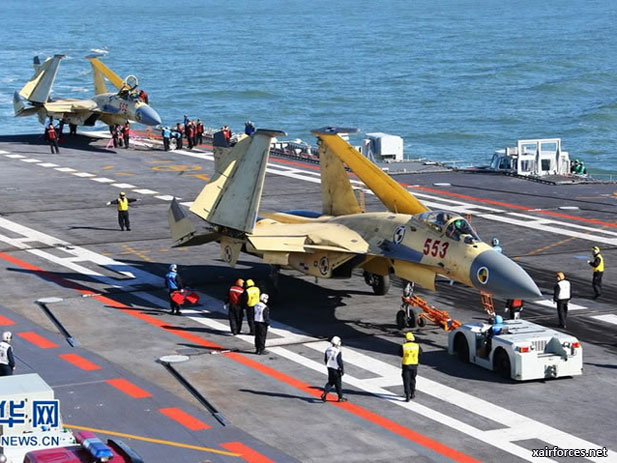
China’s Shenyang J-15 Flanker Fighter Goes To Sea; New Versions Planned

China has conducted fixed-wing operations on an aircraft carrier for the first time. The initial trial was conducted by a pair of Shenyang J-15s, numbers “552” and “553,” on the Liaoning, (side number 16), the country’s ex-Russian vessel. The aircraft were unpainted apart from serial numbers and large photo-calibration marks.
They are believed to be the second and third J-15 prototypes, and are powered by the Russian-made AL31F engine rather than the Chinese WS10H that has been installed in some other J-15 prototypes.
Test pilot Dai Mingmeng performed the first arrested landing on November 23, and short-takeoff launches were made from the carrier’s ski-jump on the same day. Four more pilots reportedly took part in the initial deck trials. Earlier in November Chinese authorities revealed that the aircraft had undertaken approaches and touch-and-go landings on the carrier during October, following several trials campaigns at the shore-based replica of Liaoning’s flight deck.
The success of this landmark event was marred, however, by the untimely death of Luo Yuang, the 51-year-old head of Shenyang Aircraft. Luo had personally overseen development of the J-15 and was aboard Liaoning on November 25 to witness the initial carrier trials when he suffered a heart attack.
Liaoning is expected to carry up to 24 J-15s and, while the vessel will provide the Chinese navy with its initial carrier capability, it is understood to be an interim/evaluation asset pending delivery of more advanced aircraft and vessels currently in development and construction. The J-15 is a copy of the Russian navy’s Sukhoi Su-27K/33, albeit with some Chinese components such as the avionics from the land-based J-11B Flanker derivative and the WS10H engine that may eventually power production aircraft. An Su-27K prototype was acquired from Ukraine in 2001 to assist the reverse-engineering process. The first J-15 prototype, with AL31F engines, made its maiden flight on Aug. 31, 2009.
On November 3 or 4 this year a two-seat variant, possibly designated J-15S, took to the air for the first time. This aircraft may be developed into a carrier-capable multi-role attacker, and is likely to share many characteristics with the Shenyang J-16 two-seat multi-role aircraft currently under development for the Chinese air force as an indigenous successor to the Russian-made Sukhoi Su-30MKK.
In related news, Russian reports continue to suggest that China intends to purchase the Sukhoi Su-35 fighter as an interim measure until its fifth-generation aircraft can be fielded, with quoted numbers ranging from an evaluation batch of four to a fleet of 48. In an uncharacteristic move, however, the Chinese defense ministry has broken silence to deny any agreement on the Su-35.
Source: By David Donald / AinOnline News - 30 November 2012
Photo: A Shenyang J-15 makes the first arrested landing aboard the carrier Liaoning. (Photo by Xinhau)
(30.11.2012)
|